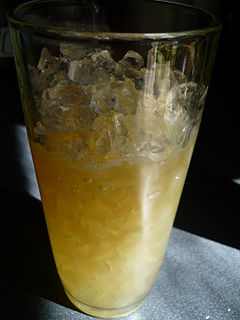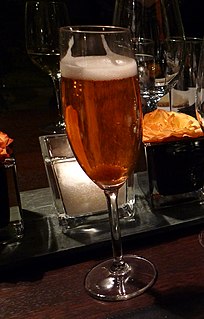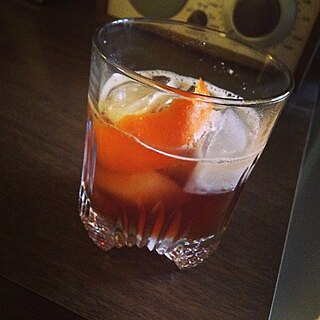
A Manhattan is a cocktail made with whiskey, sweet vermouth, and bitters. While rye is the traditional whiskey of choice, other commonly used whiskies include Canadian whisky, bourbon, blended whiskey, and Tennessee whiskey. The cocktail is usually stirred then strained into a cocktail glass and garnished traditionally with a maraschino cherry. A Manhattan may also be served on the rocks in a lowball glass.

The old fashioned is a cocktail made by muddling sugar with bitters and water, adding whiskey, and garnishing with orange slice or zest and a cocktail cherry. It is traditionally served in an old fashioned glass, which predated the cocktail.

The piña colada is a cocktail made with rum, cream of coconut or coconut milk, and pineapple juice, usually served either blended or shaken with ice. It may be garnished with either a pineapple wedge, maraschino cherry, or both. There are two versions of the drink, both originating in Puerto Rico.

The Sazerac is a local variation of a cognac or whiskey cocktail originally from New Orleans, named for the Sazerac de Forge et Fils brand of cognac brandy that served as its original main ingredient. The drink is most traditionally a combination of cognac or rye whiskey, absinthe, Peychaud's Bitters, and sugar, although bourbon whiskey is sometimes substituted for the rye and Herbsaint is sometimes substituted for the absinthe. Some claim it is the oldest known American cocktail, with origins in pre–Civil War New Orleans, although drink historian David Wondrich is among those who dispute this, and American instances of published usage of the word cocktail to describe a mixture of spirits, bitters, and sugar can be traced to the dawn of the 19th century.

Falernum is either an 11% ABV syrup liqueur or a nonalcoholic syrup from the Caribbean. It is best known for its use in tropical drinks. It contains flavors of ginger, lime, and almond, and frequently cloves or allspice. It may be thought of as a spicier version of orgeat syrup.

A sour is a traditional family of mixed drinks. Sours belong to one of the old families of original cocktails and are described by Jerry Thomas in his 1862 book How to Mix Drinks.

Angostura bitters is a concentrated bitters based on gentian, herbs, and spices, by House of Angostura in Trinidad and Tobago. It is typically used for flavouring beverages or, less often, food. The bitters were first produced in the town of Angostura, hence the name, but do not contain angostura bark. The bottle is recognisable by its distinctive oversized label. Angostura is Spanish for 'narrowing', the town of Angostura having been at the first narrowing of the Orinoco River.

The Fine Art of Mixing Drinks is a book about cocktails by David A. Embury, first published in 1948. The book is noteworthy for its witty, highly opinionated and conversational tone, as well as its categorization of cocktails into two main types: aromatic and sour; its categorization of ingredients into three categories: the base, modifying agents, and special flavorings and coloring agents; and its 1:2:8 ratio for sour type cocktails.
The brandy daisy is a cocktail which first gained popularity in the late 19th century. One of the earliest known recipes was published in 1876 in the second edition of Jerry Thomas's The Bartenders Guide or How To Mix Drinks: The Bon-Vivants Companion:
Fill glass one-third full of shaved ice. Shake well, strain into a large cocktail glass, and fill up with Seltzer water from a syphon.

A champagne cocktail is an alcoholic cocktail made with sugar, Angostura bitters, Champagne, brandy and a maraschino cherry as a garnish. It is one of the IBA official cocktails.
Maple liqueur refers to various alcoholic products made from maple syrup, primarily in the Northeast United States and Canada. It is most commonly made by mixing Canadian rye whiskey and Canadian maple syrup. Maple liqueur is considered an important cultural beverage in certain Canadian festivals.
A sling is a drink that, in its classic form, is made with sugar, hot or cold water, nutmeg, and a spirit such as gin, whiskey, rum, or brandy. In its modern form, it is made with gin, sweet vermouth, lemon juice, simple syrup, Angostura bitters, and soda water. The word sling comes from the German schlingen, meaning "to swallow".
The Angry Canadian is a variant of the Old Fashioned, where sugar is replaced with pure maple syrup, and mixed with Canadian rye whiskey. It was invented in Calgary, Alberta in 2013 by Steve Johnston.

The Toronto is a dry, rich, and mildly bitter cocktail consisting of Canadian whisky, Fernet-Branca, angostura bitters, and either sugar or simple syrup. An article in Gizmodo by Brent Rose describes it as the "most popular legit cocktail that uses fernet". It is named after the Canadian city of Toronto.
A Boomerang cocktail is a specific cocktail dating back to the early 1900s. In the 21st century it may also be a reference to cocktails that bartenders illegally shuttle back and forth between bars as a way of sharing experimentation or building comradery.

The Martinez is a classic cocktail that is widely regarded as the direct precursor to the Martini. It serves as the basis for many modern cocktails, and several different versions of the original exist. These are generally distinguished by the accompaniment of either Maraschino or Curacao, as well as differences in gin or bitters.

A whiskey cocktail is a cocktail that includes whiskey. Although whiskey is often served neat or on the rocks, it is used in many classic cocktails such as the Old Fashioned, Manhattan, and Julep. Some specifically call for Scotch whisky or bourbon whiskey.
A sherry cobbler is a classic American cocktail made with sherry, sugar and citrus. Its origins are not known in detail, but is believed to have originated sometime in the early 19th century. The earliest known mention is from an 1838 diary of a Canadian traveler to the United States, Katherine Jane Ellice, but it did not gain international name recognition until Charles Dickens included the drink in The Life and Adventures of Martin Chuzzlewit. To make the drink, orange and lemon are muddled with simple syrup, shaken with ice in a cocktail shaker, and strained into a highball glass filled with crushed ice. Garnishes include mint leaves, raspberry, and orange and lemon slices. It can also be garnished with pineapple wedges or any seasonal berries. Some recipes add pineapple juice.











